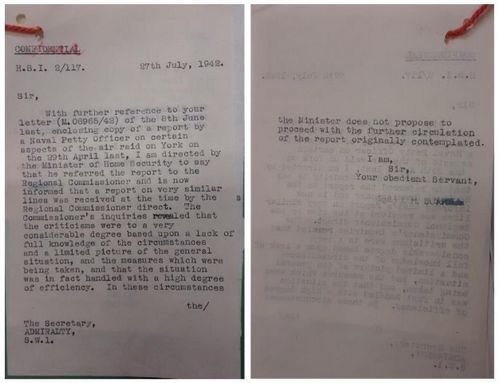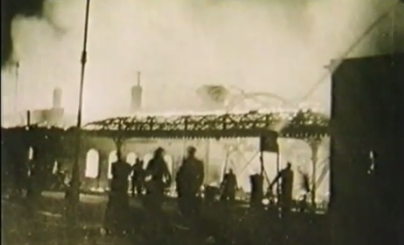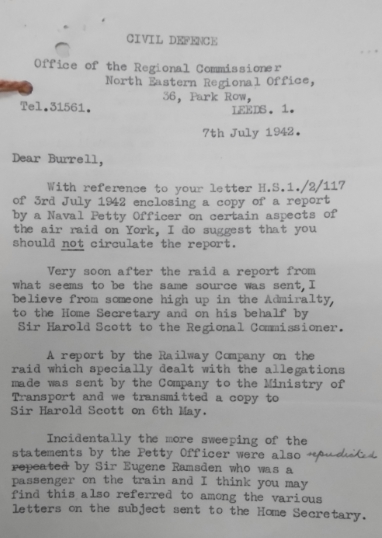The Troop Train Incident
This page includes two lengthy reports and a selection of correspondence relating to the London to Edinburgh express train which was partially destroyed in York Station on the 29th April 1942.
Following the raid, a Petty Officer from the train wrote a report on the incident.

The full text is as follows:
An escort consisting of 10 ratings, two Leading Hands and one Petty Officer, were detailed to take 5.C.Q. ratings to Hexham, proceeding as detailed to London we caught the 2215 train from King's Cross to Newcastle, all went smootly till we were just outside York when bombs were heard to fall. I, the Petty Officer in charge of the party stationed myself in the corridor of the train and saw two fires which evidently were caused by bombs, one was an ordinary coloured fire while the other burnt with a pale green light, from this I drew conclusions that some form of chemical works had been hit. All the time, the train was slowly drawing into the station, finally coming to rest alongside the platform where she stayed all night. The time was then about 0245, flares from the enemy were dropping and more bombs were dropped, mostly falling on the city, some (two or three) seemed to fall on the track one or two miles ahead of us but due to the curve on the railroad I could not swear to this. During this my escort and prisoners were still sat in the compartment as were the majority of people on the train. I should say that about 50% of the people on the train were service personnel, mostly soldiers, a few civilians left the train and found their way to a shelter situated underneath the platform. The enemy seemed to come down as low as he liked, although machine gun and cannon fire could be heard at this stage I noticed a very great absence of A.A. gun fire, the enemy had hardly any opposition from A.A. guns. In the early stages of the raid one railway official, the guard I think, came along and switched off all lighting in the carriages. He was the only railway man I had seen so far. Just then the enemy dropped about four flares right over the station and a few moments later a plane came over and dropped bombs right on the station, about three I think. I straight away fell flat on the deck of the train, I was still in the corridor, every window in the train was blasted and in the carriages where the escort was, the whole side of it was blown inwards. From reports which I gathered later, everyone in my party was alright with the exception of two of the C.Q. ratings, these two were rather badly scared. The first thing I did on getting to my feet was to go into our carriages and made certain that all my party was all right, on making sure they were , I instructed one of my Leading Hands to take the whole party down to the shelters which he did. Then the other Leading Hands and myself worked our way through the wrecked carriages astern of ours, most of them were nearly matchwood. At this stage three small fires were seen on the platform nearest the train and if there had been any sandbags handy we could have put them out. There was still an absence of station staff, the Leading Hand and I continued going through the carriages to see if we could find anyone injured and eventually we came to one that had a Naval Commander in and he was pretty badly hurt so we managed to get him onto the plaform and started to carry him to the shelter. All the offices and canteen buildings on the far side of the train were well alight by now, also the whole of the afterpart of the roof was burning fiercely. We carried the hurt Naval Commander along the platform where we drew near the place where we had noticed the three small fires and the carriages were just one blazing inferno. Whether these three carriages had been set on fire by the three small fires or not I don't know but I feel sure that had we had the sandbags to put the fire out in the first place, and of course, if the railway people had either gone astern or ahead of the train, then perhaps the train and all the personal belongings could have been saved. The L.S. and I managed to get the injured Naval Commander down to the shelter only to find that no First Aid parties were present. One man and a woman were doing their best for the injured of which there were about a dozen in that shelter. I stayed down in that shelter for some time and had a look around. Burning debris from the station kept falling down the steps so I looked around for some means of exit. There was a grill at one end, locked, a door nearly at the other end also locked, and apart from that, the only other means of exit was from a manhole which was about two feet square. It was just after this I saw the railway officials for the first time and they unlocked the door and evacuated the people in the shelter and removed all the wounded. On coming onto the platform again you can imagine my amazement that no hoses were in use yet. Anyway just after the first one started and I estimate that it at a good twenty minutes from the time the bombs fell to the time the first hose was in use. This hose was manned by three sailors and seeing quite a number of sailors and soldiers standing idle, also two more hoses flat (underlined). I traced them to the end and, to find that they were only on the platform with no hydrants in sight. One hydrant was then found on the opposite platform and the hose rushed over to it. It was then found that no adapting pieces was (sic) there and it could not be found, the handle for turning on the water would not fit, this state of affairs was disgusting. The second hose was then taken over three sets of train lines and then fixed up and put into use. It was easily an hour before the second hose was in use, about half a dozen foamites were put into use, but these were useless. I then went and mustered my party, the reason I left was because there was nothing for me to do and it was the same with many more ratings who would have helped if there had been anything for them to do. It was about two hours from the time the bombs fell, to me seeing the third and fourth hoses in action, presumably from trailer pumps. One of my leading hands thought it a good idea for him and the rest of the party to go in the City and try to get a hot drink. I thought it a good idea too because the only thing everyone was doing was standing about, so I put the two leading hands in charge, ordered them to keep together and off they went. The deep sea cadets very kindly let them wash and gave them hot tea and biscuits. We eventually left York at about 1100 and the rest of the journey was uneventful. The kit of the C.Q. ratings was in the guards van and the half where it was, was gutted with fire; I am not sure whether it was saved or not, because the station people would not let us touch a thing from the guards van which of course was all jumbled up, anyway I informed the R.T.O and they took particulars and said if it was found to be all right they would send it on to H.M.S. Standard. I also informed the C.O. of the STANDARD and he said he would ring up about it.
..........................
I wish to commend the escort on the magnificent way they worked in keeping the C.Q. ratings together during the whole journey, especially the two Leading Hands.
..............................
Points which really want much improvement at York are -
1. More and efficient fire fighting gear.
2. Railway fire services want much more instruction.
3. Arrangements for hot drinks to be served.
4. Above all use common sense and keeping trains out of the stations.
5. More anti-aircraft defence.
(Sgd) J. Jacques, Petty Officer
As you can imagine this report caused "quite a stir" and, via the desks of senior Officers and other Government officials, it reached the desk of the Home Secretary.
The fierce fires caused in York Station by high explosive and incendiary bombs.
The flames compared to the size of the water hose gives some idea as to the difficulty of controlling the fire.
It was felt in York that many of the allegations in the report were rather sweeping and very unfair. A letter from the Regional Commisioner contains some interesting background information and an extremely important correction.
The difference between the statements being "repeated" and "repudiated" is critical.
A response was sent from the Chief General Manager of the LNER Station.
The full text is as follows:
I enclose a report on Fire Watching and Fire Prevention arrangements asked for in your letter of the 30th April. My general comments on the report are that nowhere was there any shortage of staff for dealing with the fires and that considering the conditions with which they had to deal, the efficiency of the arrangements was very satisfactory.
I also enclose copy of a letter dated 1st May from the Flag Officer in Charge of the Tyne Area to the Regional Commissioner, No. 2 Section, Leeds, to which is attached a report to the Flag Officer from Commander J.M.P. Newdigate, R.N. who is the Commanding Officer of the Royal Naval Camp, Hexham. I have obtained a copy of the report through the courtesy of Sir William Batholomew, and as the statements made in the reports may reach you through other channels, I think it well to comment upon it. The statements as appearing in Commander Newdigate's letter vary from the actual facts. It will be observed that the letter is based on the verbal statement of a Petty Officer and it may be that, having been obtained in this indirect way, the statement has become somewhat distorted. The Petty Officer was in charge of a party of K.C. ratings under escort, and it is probable that this very proper pre-occupation with keeping his party intact, prevented him from obtaining a more comprehensive view of the conditions in York station. The train in question, the 10:15pm from King's Cross, arrived in York at 2.53am about 13 minutes after the "red" warning. The passengers were at once warned by an Assistant Station Master and a Station Inspector and were advised to take cover. A large number of passengers left the train and took cover, but others preferred to remain in it. At about 3pm a high explosive bomb fell in the Coal Yard outside the Station to the West and the blast caused some injury to passengers remaining in the front part of the train. At 3.26 am a high explosive bomb made a direct hit on the East side of the Station demolishing the Parcels Office and surrounding buildings, and the blast caused further injury to passengers in the centre of the train. Simultaneously with the high explosive bomb, showers of incendiary bombs fell on the station buildings and station roof, and practically instantaneously the South end of the station was ablaze and the six coaches in the middle of the train were also set on fire by the incendiary bombs. The flames were fanned by a strong north-westerly wind and the whole of the Southern half of the main roof burned fiercely. The important fires to which the fire-fighting personnel directed their attention were those in the buildings, the roof, and the train; such small fires as there may have been on the platform were of no importance, the platform in question consisting of stone slabs. The suggestion that the conflagration could have been prevented if the three small fires on the platform had been put out showed a complete failure to grasp the situation. Within five minutes of the fires starting the Assistant Station Master got a hosepipe rigged from No.1 platform opposite the burning train. Unfortunately, the explosions had damaged the main and no water could be obtained. He then instructed all the staff and large numbers of sailors, soldiers and airmen, who were willing helpers, to get extinguishers and other equipment from the trains in the station, and these were quickly brought to bear on the fires. At the same time steps were taken to rig up a second hose on No.14 platform as soon as it was found that water was available there. This hose was brought into operation within 20 minutes of the start of the fires. The Assistant Station Master had before this made arangements for the train to be divided into three parts, the 14 undamaged front and behind the six coaches which were on fire being drawn safely away. There was a parcels train standing at No.15 platform and a hose could not be rigged from that platform until the parcels train had been moved. This was done as soon as it was found that the line was undamaged for a short distance north of the Station, and the hose from No.15 platform was brought into operation at about 4am. The statement, therefore, that an hour passed before a second hose was rigged is not correct.
With regard to the connection not fitting, it is true that the first connection taken to No.15 platform was of the wrong type, but the Assistant Station Master at once discovered this and the right type was substituted within two minutes.
The Petty Officer states that he did not form a good opinion of the arrangements made to deal with casualties and that there did not seem to be any organised first-aid dressing stations. This was no doubt true at the time the Petty Officer made his observations as the First Aid Station, which was in the neighbourhood of the Parcels Office, had been destroyed by a direct hit. In fact, the Station Foreman who lost his life in the raid, was actually in the First Aid Station getting additional equipment for injured passengers when the direct hit occurred.
In addition to the three hosepipes which were got to work in the Station, the A.R.P. were quickly on the job outside the Station and were playing on the fire by 4am. The report which I have received is to the effect that the A.R.P arrangements worked admirably and that the static water, as well as the National Fire Service arrangements for pumping water from the river, were of great assistance.
It is true that a good deal of time elapsed before an ambulance arrived, but it was certainly less that two hours. It must be borne in mind that the telephone service had ceased to function and that the reporting point from which an ambulance would normally have been summoned had been destroyed. I am, however, assured that no difficulty was caused through this delay, as cases requiring to go to Hospital were removed by car and Army lorry. The first aid equipment was ample and there was not (a) shortage of stretchers. Improvised stretchers had to be used owing to the destruction of the ambulance room. In addition to the station staff, there were many willing helpers both with fire-fighting and first aid, and a special word of praise is due to many sailors, soldiers and airmen, who were in the station, as well as to the Company's female staff. I myself reached the station at about ten minutes past four, and while I am dependent on reports as to occurrences before that time, I can from then onwards speak from my own observation of the efficiency, energy and cheerfulness with which the emergency was tackled by the staff and many volunteers. Sir Eugene Ramsden, M.P. for Bradford North, who looks after the Parliamentary interests of York, was a passenger in the train and was in and around York Station for several hours after the raid. He tells me that he was astonished at the speed with which the conflagration was got under control and will be ready to answer any questions on the subject.
I am sending a copy of my letter to Sir William Bartholomew.
(Signed) C.M. Jenkin Jones

The aftermath of the raid inside York Station showing the remains of the burnt-out troop train.

This letter from the Ministry of Home Security seems to signal that the subject was now closed.
Click this link for a larger view.
Documents and images on this page are copyright of the National Archives.


